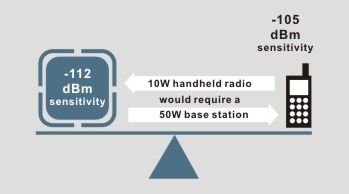The Truth About Watts in Your PMR Radios
14 Mar. 2017 Information
Do you believe that a more powerful PMR radio enjoys better coverage? If so, think again.
Many people have the wrong idea about how powerful their PMR radios need to be. Sure, walkie-talkies need high power to transmit and receive signals between radios, because they operate without a network.
Radio output power is a big consideration when specifying
walkie-talkie radios. That’s because they need the power to transmit and receive signals between radios without any network being involved.
But PMR radios work completely differently, making high output power far less significant.
PMR radios only need to link to a nearby base station in the network – they simply don’t need high power to punch through to another terminal directly. The only exception is when they are switched to Direct Mode (DMO), which is relatively rarely used in practice.
Ah, you say, vehicle radios are more powerful and they enjoy better coverage. Yes, it’s true, mobile radios do have more output power - but that’s not why they get service in places where handhelds struggle. That’s mainly because vehicle radios have a long antenna that is in just the right place. It also helps that signals are not blocked by the user’s body, which can seriously affect handheld radios.
Some base stations are just good listeners
PMR radios and base stations communicate back and forth with each other. A good, sensitive base station, listens well, especially when equipped with the recommended antenna solution.
That’s important because the less power that a radio uses, the longer its battery will last. It can make a critical difference to professionals in the field who don’t want to be let down by a flat battery when they most need their radio.
On balance, 1 W is enough
Communication between PMR radios and base stations is two-way. There is the downlink transmission from the base station to the radio and the uplink transmission from the radio to the base station.
The radio network should have a balanced uplink and downlink - there is no point in one being stronger than the other. A TETRA radio network, for example, often uses base stations transmitting at 25 W. To find the radio’s optimal output power we need to know the sensitivity figures of both the radio terminal and the base station.
Let’s say the radio has -105 dBm sensitivity and the base station has -112 dBm sensitivity. It turns out that a typical 25 W base station, with diversity and panel antennas for uplink, requires the device to transmit at 1 W. This guarantees maximum coverage.
Any more power in the radio brings no benefit, except if the radio is used in DMO. So beware of claims that you need very powerful PMR radios to get the coverage you need. It’s not true and can actually degrade your operational efficiency.
Don’t worry about power – your radios will have all they need.
(Source: securelandcommunications.com)
